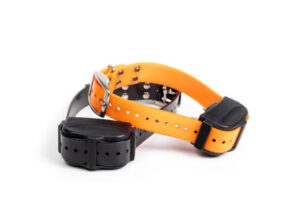Explaining the tools we utilize, their purpose, and how they fit into a well-rounded dog training plan is a regular topic of discussion with potential clients. Consequently, we also have to address numerous myths and misunderstandings regarding these tools, and assist clients in abandoning harmful training techniques that may have contributed to where they are today with their pup’s training and behaviors. One of those stubborn myths is that all “shock collars” are made the same.
Let’s put this in simple terms: false.
If you have been a prior client of ours and have remained loyal over a period of time, you are likely aware that E-Collars are a component of our dog training programs. We highly praise the advantages of using E-Collars for training purposes. They enable you to effectively interact with your dog in a manner that adjusts to the circumstances, they provide you with a way to enforce established rules, they allow you to communicate with your dog whether they are close to you or far away, and overall, they are exceptionally gentle tools for dog training.
These, along with various other misconceptions, play a significant role in negatively portraying these impressive devices. This blog aims to redefine and establish clear distinctions between a top-quality E-Collar and a generic shock collar.
What is the Difference Between an E-Collar and a Shock Collar?
The fundamental difference lies in the definition. It needs to be acknowledged that there is no fixed description for either term; you cannot refer to the dictionary to find a single meaning. If someone were to argue that E-Collars and shock collars can be used interchangeably, they would be just as incorrect as I am in stating that they cannot. Nonetheless, there is a significant contrast between the two from our standpoint and the perspective of most trainers who use them. However, it is crucial to establish a mutual understanding of each term in order to have an effective discussion about dog training tools. For collaboration with Off Leash K9 Training and for this blog, this is how we specifically define these tools.
What is a shock collar?
A shock collar is any tool that uses electrical stimulation to apply a correction, or an undesirable stimulus intended to reduce a behavior. When we talk about shock collars at Off Leash K9 Training, we specifically mean low-quality tools that are widely available online and in large pet stores. We discourage the use of these shock collars due to their inconsistent and unreliable nature, which may lead to discomfort for the dog. Although the technology used in these generic shock collars is technically similar to higher-quality remote collars, they are often of lower quality, potentially inhumane, and difficult to condition properly.
What is an E-Collar?
When we mention “remote collars” or “E-Collars,” we are specifically referring to the top-notch versions of this technology, which only includes a select few reputable brands. Remote collars tend to be more expensive, usually starting at around $200 and up. For models that cater to high drive or difficult dogs, or those that have multi-dog functionality with multiple receivers, the price can go up to a few hundred dollars. However, the cost is always worth it because reliable remote collars are sufficiently sensitive to determine appropriate levels, effectively condition dogs, and elicit suitable responses.
You might come across others on the internet referring to premium collars as “E-Collars,” which is a commonly used term that has become associated with a group of similar products (similar to how people use “Tupperware” for food storage). It is worth mentioning that we happen to utilize E-Collar Technologies as our brand of choice.
An “E-Collar” is essentially a collar equipped with a stimulation mechanism, comparable to an electric fence collar. The collar is operated by a handheld remote controlled by the handler. With this remote, you have the ability to effectively manage your dog’s behavior within a range of 400 yards. This grants your dog a significant degree of freedom while alleviating any concerns you may have about them wandering off. Contrary to popular belief, the collar is not intended as a form of punishment or a painful “shock” but rather as a tool for training and communication with your canine companion. It generates a subtle electrical current between two contact points situated on the collar.
In earlier times, this particular type of collar was employed as a “shock collar” and numerous dog owners lacking experience attempted to utilize it to intimidate their dog into obedience. In the effective training method we use, your dog is never subjected to being “shocked into obedience” or mistreated. Unlike a shock collar, the E-Collar is used to capture the dog’s attention and maintain its focus on following the instructions of the handler. It is similar to someone gently tapping your shoulder to grab your attention or setting your phone on silent mode, so it alerts you when someone is calling. We educate the dog to heed those gentle taps and understand that the taps signify, “I am trying to grab your attention.”
How are shock collars and remote collars different?
There are various distinctions between shock collars and remote collars, as I have already mentioned, such as their cost and overall standard. However, it is of utmost significance for dog enthusiasts and potential purchasers to grasp these disparities so as to consider the use of effective tools and prevent the employment of collars that may harm dogs and yield bad training outcomes.
Price Point
As mentioned previously, there is a significant difference in price between a generic shock collar and a high-quality remote collar. While a shock collar typically costs between $25 and $50 when purchased online, reputable brands like Petsafe can charge up to $150 in large pet retail stores. On the other hand, a remote collar is priced just below $200, but can be even more expensive for multi-dog units or specifically-designed E-Collar units for energetic dogs. It is worth noting that the majority of our clients utilize the ET-300 Mini Educator offered by E-Collar technologies.
Although the cost of a high-quality remote collar is generally higher than that of a shock collar (although not always), it is important to acknowledge that the quality you receive for that price is significantly better. While a generic shock collar may be $100 cheaper than a remote collar, it is worth mentioning that a remote collar is designed to be more durable. Additionally, if you purchase a reputable brand’s remote collar, you will typically receive a warranty and have access to customer support in case you encounter any issues with the product.
Furthermore, when considering various aspects, it can be seen that a remote collar is not only a superior training tool but also more compassionate towards dogs. Taking into account all of these factors, the value of a high-quality remote collar far exceeds the price difference of $100. In fact, compared to its quality, the price point is exceptionally favorable.
Stim Levels
In the process of training dogs, the term “stim” represents the electrically-induced stimulation of the muscles that is produced by the receiver of the remote collar. When the stim feature is activated on the collar, the electricity causes the muscles to tighten. When the intensity is low, it does not result in any movement or discomfort for the individual wearing it. However, when the intensity is increased, it can create a tingling or pricking sensation on the skin and cause the muscles to contract more extensively. In dog breeds such as bully breeds and other muscular dogs with short fur, it is possible to observe the muscle twitch when the stim is applied.
In all honesty, referring to the collar as a “shock” collar is quite inaccurate, but as already mentioned in this article, arguing over the semantics is pointless.
This technology bears a strong resemblance to the electrical stimulation utilized in TENS units for muscle stimulation treatment. From my personal experience, I have utilized both a TENS unit and experimented with remote collars on myself at certain times, and the feeling is essentially identical, the only difference being that the TENS unit encompasses larger surface area with its pads compared to the contact points on the remote collar receiver.
The sensitivity and range of levels on the device differentiate a generic shock collar from a high-quality remote collar.
A remote collar of good quality, such as the ones utilized by us here at Off Leash K9 Training, will feature a range of levels from 0 to 100. The lowest levels are extremely low, to the point that most dogs do not even perceive the sensation until reaching at least level 10. Certain dogs may not even become aware of it until much higher levels. Based on our experience, a level 10-20 is commonly considered an appropriate “working level” for numerous dogs.
These low, sensitive levels are not included in shock collars. Level 1 is consistently set at a significantly high intensity, often causing great discomfort or even pain for the dog. These levels are typically reserved for the purpose of halting extremely severe or hazardous behaviors.
Range
The range of a remote collar system will vary depending on the specific unit you purchase. For instance, from E-Collar Technologies, different models have a range between .5 miles and 1 mile. This means that you can utilize the stim, tone, or vibrate function within that distance with equal effectiveness. The receiver can receive signals from the remote within that range even through most obstacles such as walls and large objects.
Below is the typical range of remote collars offered by E-Collar Technologies.
| E-Collar Model | Range (in miles) |
| Micro Educator (ME-300) | 1/2 miles |
| Mini Educator (ET-300) | 1/2 miles |
| Educator (ET-400) | 3/4 miles |
| The Boss (ET-800) | 1 mile |
Standard shock collars do not offer the same effectiveness or coverage. The signal of these collars can be significantly hindered by walls and everyday objects. Moreover, the range of a generic shock collar is much shorter compared to a high-quality remote collar. Upon reviewing shock collars on amazon.com, it appears that a distance of 1/4 mile is typical, which is quite limited, especially when there are obstacles in the environment.
Contact Points and Accessories
Accessories are crucial in determining the success or failure of the training process with remote collars. By accessories, I am not referring to optional yet enjoyable extras such as lanyards and cases. I am referring to enhancements or specific components like upgraded contact points, controller management, and other supplementary features that directly impact the user-friendliness, effectiveness, or outcomes of the training.
1.) Bungee collars are a type of accessory that can greatly enhance the connectivity you experience while placing a remote collar on your canine. Fundamentally, these collars possess an additional stretchy component which enables the collar to bend alongside your dog’s motion, react to routine changes in neck width (which can differ throughout the day, particularly during physical activities), and uphold uninterrupted connectivity throughout the entirety of the process.
2.) It will not be simple to replace shock collars with bungee collars or any other type of collars they are not originally designed for. This is particularly unfortunate because the nylon collars that come with shock collars have a tendency to loosen and slip, resulting in inconsistent contact.
3.) Having the proper contact points is crucial, and they will vary for each dog. It is important to consider factors such as the dog’s size, fur length and thickness, allergies, and more when determining th e right contact points. Typically, a remote collar will include at least two sets of the most commonly used contact points. However, using more suitable contact points will ensure consistent levels of stimulation and prevent any accidental over or under-stimulation, which can be extremely important in various situations.
e right contact points. Typically, a remote collar will include at least two sets of the most commonly used contact points. However, using more suitable contact points will ensure consistent levels of stimulation and prevent any accidental over or under-stimulation, which can be extremely important in various situations.
4.) It is not convenient to locate replacement contact points for shock collars, and they are not suitable for wing tips and comfort pads. These contact points are specifically designed to assist with dogs that have thick coats and dogs that are sensitive. In addition, the standard contact points included with many shock collars often have a peculiar rubber or silicone texture. These off-brand companies attempt to advertise these contact points as providing greater comfort for the dog, but the rubber surface actually clings to the fur and can tug in an uncomfortable manner, in contrast to the smooth glide of stainless steel contact points.
5.) Dog handler holsters and clips are specifically designed to simplify your life as the individual in control. The available options will differ depending on the specific brand and model you select. E-Collar Technologies offers a range of choices such as belt clips, holsters, retractable line clips, and my personal preference, the magnet “AnyWear” clip, which I find perfect for securing the controllers of my own dogs. Regarding shock collars that are not specific to a certain brand, all I can say is: best of luck. Typically, you are limited to the strap or cord that comes with it, and this may be acceptable in numerous scenarios. However, once you have experienced the convenience of the assortment of additional attachment choices provided by superior brands, it becomes difficult to envision reverting back.
6.) Finger trainers are an additional user-friendly item. They are compact clips that you wear on your fingers like a ring and they communicate with your wireless collar controller. This controller can then activate the receiver on the dog’s collar. This saves you from searching for a remote and allows you to keep your hands free for other tasks, such as holding a leash or providing treats, while still being able to use the remote collar. The controller can be kept in your pocket, and you can simply tap the finger exerciser ring to utilize the stimulation, sound, or vibration settings. The finger trainers are available in a kit with a specific setup and cannot be added to an already existing setup. I am aware that Dogtra has been offering a finger trainer system for their ARC product for a while now, and E-Collar Technologies also provides a finger trainer version for their Mini Educator (ET-330). I have yet to come across a shock collar system that provides such versatility and recognition of the necessity to keep your hands free for other tasks.
Additional Functionality
Premium remote collars typically have several additional useful functions. One of my personal preferences is the flashlight feature, enabling you to locate your dog in dim lighting, aid their navigation, and enhance their visibility to drivers and others during the nighttime. This attribute can be effortlessly activated or deactivated directly from the remote, eliminating the need to clumsily search for a switch on the collar itself.
I am aware that dog lovers adore those illuminated collars for dog safety, and although they are acceptable for their intended purpose, I find it difficult to comprehend why people spend considerable amounts of money on them; a reliable e-collar can accomplish the same task and offer additional benefits! Furthermore, the e-collar flashlight can be recharged alongside the system, eliminating the need to purchase replacement batteries!
It may be challenging to locate a dedicated flashlight feature on a shock collar, and I cannot vouch for the dependability of that feature if it is available; however, the one found on the Mini Educators for my own dogs provided by E-Collar Technologies has proven to be a wonderful feature to possess.
Another additional feature that distinguishes remote collars from shock collars is the option to use them on multiple dogs, which is included in many models. What I mean by this is that you can buy a remote collar for one dog, and later on, purchase an additional receiver when you get a second or third dog. The availability of this feature will vary depending on the specific model you select, but it can actually be cost-saving in the long run and allow you to control all your dogs with just one remote.
Durability
Shock collars are prone to damage, experience wear and tear in daily activities, and frequently require expensive replacement components. In addition to their inadequate effectiveness in securing the receiver, these collars typically come with a low-quality nylon strap that quickly deteriorates and tears. Furthermore, the remote control is often either inconveniently bulky and clumsy, or excessively small and fragile.
In contrast, remote collars are designed to endure over time. They can withstand being immersed in water, including saltwater, and are resistant to dirt, rust, and impact damage. Additionally, they are equipped with a robust biothane collar that can handle rough handling. Straight out of the packaging, the remote for a top-notch shock collar will give a sense of superior quality when held; it will possess some heft, provide a comfortable grip, feature a clear display screen, and boast an intuitive design with buttons placed strategically for swift and effortless response to any situation. Remotes from E-Collar Technologies typically include a supplementary case that enhances durability and can be conveniently removed, cleaned, exchanged, etc.
Furthermore, the upkeep of the premium remote collars is exceptionally simple. They can be easily recharged using the included cable and do not require the use of new batteries. Additionally, many E-Collar Technologies systems are equipped with removable protective cases for the remote, making it effortless to clean.
In the end, the well-known brands will also provide a comprehensive manufacturing guarantee, usually lasting two years, something that will definitely not be found with generic shock collars.
Reliability
Without a doubt, remote collars are unquestionably more dependable. The intensities are consistently steady (signifying that a level 12 will consistently deliver the same degree of stimulation), applicable in various settings (such as wet conditions and despite obstructions), and reactive (pressing the button will result in a distinct outcome, consistently). At times, people fail to appreciate the significance of this dependability. A top-quality remote collar will be there for you when your canine dashes off into the forest. It will provide precisely the level of stimulation you choose, ensuring that your dog is never subjected to a correction-level stimulus when you only intended to encourage attentiveness. Furthermore, they will not be overwhelmed when you truly require a high level, such as during an urgent situation. The dependability is crucial for ensuring the safety of your canine during critical circumstances, and for consistently maintaining command over the levels.
Training Application
When we engage in remote collar training for dogs, our aim is not to excessively correct them. I want to reiterate this point. The purpose of remote collar training is not to subject the dog to harsh corrections. Instead, it involves a significant amount of gentle training to condition the dog’s understanding of the collar’s sensation, its significance, and how to control and eliminate it. Is it possible to utilize a remote collar for corrections? Yes, we do make use of them for corrections whenever appropriate; they prove to be highly advantageous devices in delivering corrections that align with the intensity of a particular behavior. However, that does not make up the majority of the work. It is not possible to provide crucial basic training using shock collars. The intensity levels are excessively high. Shock collars are primarily useful as a means of discouragement, whereas a remote collar has a much wider range of applications beyond just correcting undesirable behaviors. Ultimately, in the grand scheme of things, a shock collar is essentially a variation of a remote collar that fails to deliver on the positive aspects of the remote collar. These positive aspects include sensitivity levels, long-lasting construction, reach, and ease of use, which are what make remote collars effective and completely ethical instruments.
About Off Leash K9 Training Northeast
OLK9 Northeast is a company that provides off-leash dog training services in the states of New York, Vermont, New Hampshire, Massachusetts, Connecticut, and New York City. We specialize in private lessons, Board & Train Programs as well as behavioral modification programs. Our aim is to help owners gain better insight into the reasons behind their dogs’ behaviors, which ultimately leads to a stronger relationship between the owner and the dog. Contact us today to start your Off-Leash journey!




